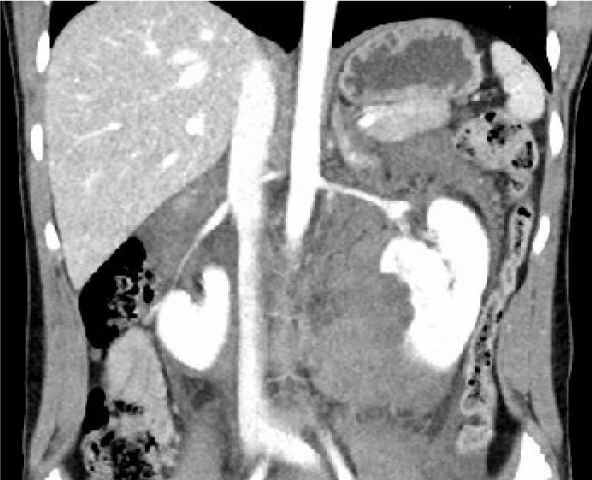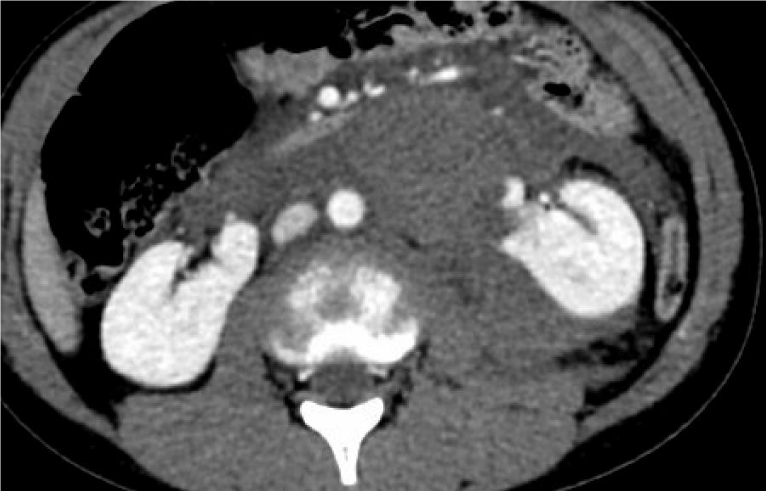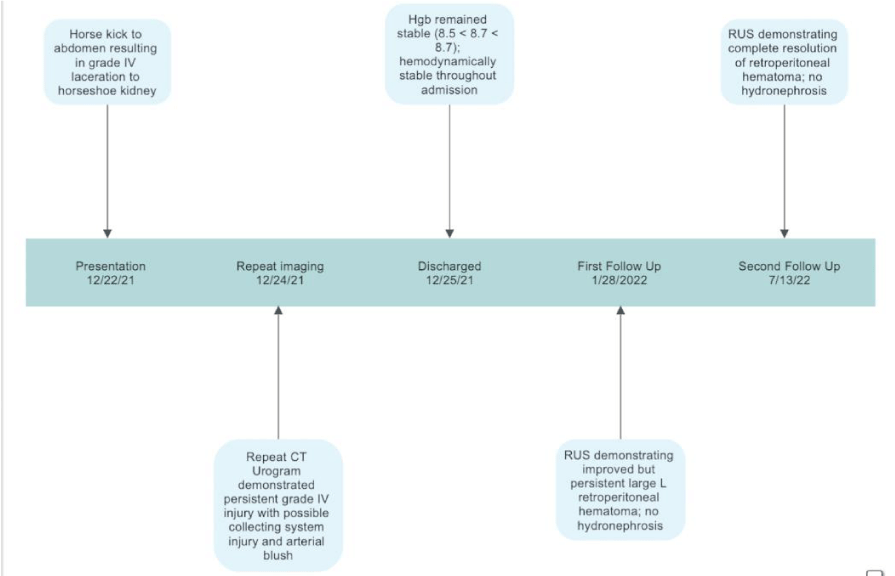Archive of Urological Research
Case report: Conservative management of a blunt trauma to a horseshoe kidney
Ross Micciche*, Jeffrey White, Laura Cornwell and Katie L Canalichio
Cite this as
Micciche R, White J, Cornwell L, Canalichio KL (2024) Case report: Conservative management of a blunt trauma to a horseshoe kidney. Arch Urol Res 8(1): 008-011. DOI: 10.17352/aur.000049Copyright
© 2024 Micciche R, et al. This is an open-access article distributed under the terms of the Creative Commons Attribution License, which permits unrestricted use, distribution, and reproduction in any medium, provided the original author and source are credited.With trauma representing the leading cause of death in children, and renal injuries representing a large proportion of that trauma, understanding the appropriate management of renal injuries is vital to preventing pediatric morbidity and mortality. Cases involving aberrant anatomy are even more crucial to understand as there is less data on appropriate management. Here, a case is presented of a 7-year-old male presenting after a horse kick to the abdomen resulting in traumatic disruption of a previously unknown horseshoe kidney and the subsequent conservative management. The patient presented with abdominal pain, leukocytosis, and elevated liver function enzymes. An abdominal and pelvic Computed Tomography (CT) demonstrated a horseshoe kidney with a grade IV laceration to the isthmus and left lower pole of the kidney resulting in fracture/disruption of previously fused horseshoe kidneys. Additionally, there was a large retroperitoneal hematoma and hemoperitoneum. The patient was successfully managed with observation, and hemodynamic monitoring and has had resolution of hematoma and preserved kidney function through 8 months of follow-up. In conclusion, this is an example of how a patient with complicated renal anatomy can be managed conservatively to model for potential future cases.
Introduction
Horseshoe kidneys occur in 1 of 400 births, with a predisposition for males in a 2:1 ratio. Renal injuries occur in 10% of blunt abdominal traumas, and 7% of these injuries occur in kidneys with acquired or congenital disorders [1]. Of these congenital disorders, horseshoe kidneys pose a unique challenge in management due to their complex anatomic variations and extreme vulnerability in the setting of abdominal trauma. The main variations include differences in the level of ascent, orientation of the kidneys, and where they are fused. In a U-shaped horseshoe kidney, the kidneys are fused medially at their lower poles with the isthmus overlying the vertebral column. Another less common variant has the kidneys fused laterally with one kidney in a vertical position and one in a horizontal position. Here, the kidneys are still fused at their lower poles, but the isthmus is located lateral to the vertebral column [2]. In either scenario, it is equally relevant that the kidneys’ vertical position rests anywhere along the axis of normal kidney ascent. The ascent is usually hindered by the Inferior Mesenteric Artery (IMA) and is most commonly located in the lower lumbar portion of the abdomen. This puts the fused kidneys at increased risk of abdominal trauma [3]. When presented with a blunt abdominal trauma your management options are reliant on each clinical situation but include conservative management, endovascular intervention in the form of vascular embolization and/or ureteral stenting, and open operative exploration. Conservative management includes observation and supportive measures; i.e., hemodynamic monitoring, blood transfusion, blood pressure support, antibiotics, etc [4]. Further complicating the management of patients with horseshoe kidneys is the fact that 60% of horseshoe kidney patients are asymptomatic and diagnosis is often obtained incidentally at the time of abdominal trauma [1]. This makes the quick and correct diagnosis of horseshoe kidney injuries of utmost importance to carry out adequate treatment. We report a case in which a traumatically disrupted horseshoe kidney was quickly recognized and successfully managed using conservative techniques, which we feel was crucial given the higher risk of renal parenchyma loss in operative exploration of mispositioned kidneys with anomalous vascular supply [5].
Case description
This is a 7-year-old boy with no past medical history who presented as a transfer to our facility after being kicked in the abdomen by a horse. The incident occurred around 9 hours prior to the presentation. The patient initially felt fine, but later developed gross hematuria, so he was taken to an outlying rural hospital for evaluation. There, he was hemodynamically stable. Labs showed a leukocytosis of 29,000, Hemoglobin (Hgb) of 12.2, and elevated LFTs (Aspartate aminotransferase (AST) of 106, Alanine transaminase (ALT) 115, Alkaline phosphatase 235). CT abdomen and pelvis with intravenous (IV) contrast was performed and demonstrated a small volume of abdominal free fluid, moderate hemoperitoneum and retroperitoneal hematoma, and a horseshoe kidney with traumatic grade IV laceration with fracture and separation of the lower fused portion. No delayed imaging was obtained. No other injuries were identified. The patient was transferred by air to our facility for further evaluation
On presentation, the patient was afebrile and remained hemodynamically stable. The patient’s only complaints were left-sided abdominal and flank pain with gross hematuria. A physical exam revealed diffuse abdominal tenderness and guarding without costovertebral (CVA) tenderness. Labs were redrawn at our facility and demonstrated a Hgb of 11.5 (from 12.2 outside the hospital), ALT of 89, and Creatinine of 48, urinalysis with > 180 red blood cells. Upon discussion with the family, it was unknown that the patient had a horseshoe kidney. Prenatal ultrasounds were described as normal to the parents, and the patient had received no abdominal imaging since birth. After reviewing the CT images (Figures 1,2), it was determined the patient had a Grade 4 kidney laceration with disruption of a horseshoe kidney. The majority of the injury was to the lower pole of the left kidney, where a large retroperitoneal hematoma was present, and a small amount of vascular blush emanated from around the left renal hilum. It was decided to observe the patient and manage conservatively due to his stability. He was admitted to a med-surg bed and underwent serial monitoring of his hemoglobin and hematocrit every 12 hours, with the intention of obtaining a repeat CT scan with and without IV contrast with delayed imaging 48 hours after injury. He was also placed on bedrest and a Foley catheter was placed to monitor his hematuria. On placement of the catheter, there was no gross hematuria noticed, just amber urine. On post-admission day 1, his Hgb dropped to 10.5. He was stable otherwise. His catheter was draining yellow urine and pain was controlled. He was hemodynamically stable and his liver enzymes normalized. He was continued on bedrest with bathroom privileges. On post-admission day 2, his hemoglobin dropped to 8.7 but plateaued here for subsequent checks. His kidney function remained normal, and he remained hemodynamically stable. He had repeat imaging with a delayed phase that again demonstrated a complete disruption of a horseshoe kidney with a grade 4 laceration, a large retroperitoneal hematoma, stable in size, and a vascular contrast blush on the left side, anterior to the renal hilum. There was a new finding of small contrast extravasation from the collecting system of the right kidney, though most contrast made its way down each ureter bilaterally and ultimately filled the bladder. The patient was observed for an additional day. On post-admission day three, he had his catheter removed and was urinating without issue. His pain was controlled. His hemoglobin remained stable at 8.5. He was discharged from the hospital on the third day of admission with close follow-up planned with renal ultrasound. Recommendations were given for monitoring for recurrence of abdominal pain, hematuria, lightheadedness, nausea, or vomiting. A follow-up renal ultrasound was obtained one month later that demonstrated the persistence of a small left-sided retroperitoneal hematoma, but the patient was asymptomatic. A repeat renal ultrasound 6 months later demonstrated complete resolution of the previously demonstrated hematoma. The sequence of events can be seen more visually in the attached timeline (Figure 3).
Discussion
Detailed here is a rare case of abdominal trauma resulting in severe, bilateral renal injury secondary to the aberrant anatomy of a horseshoe kidney. It highlights how this variant anatomy can predispose patients to injury that otherwise would be avoided in those with normal anatomy. It also underscores a potential treatment algorithm for when these rare cases present themselves for future providers.
Traumatic injuries represent the leading cause of death among children. Abdominal trauma, specifically, poses an increased threat to children, as their unique anatomy renders certain organs, like the kidneys, more at risk of injury than in adults. Renal injuries are present in about 10% - 20% of abdominal traumas in children, and renal congenital anomalies are three to five times more common in this subset of children undergoing CT scans for abdominal trauma than in the general population [6-8]. Additionally, it has been described in the literature that congenitally anomalous kidneys are at an increased risk for surgical exploration than congenitally normal kidneys. In one study, patients with congenitally abnormal kidneys represented only 12% of the renal injuries but 75% of these patients underwent surgical exploration, compared to less than 20% in the general population [9]. In a review of case reports, a majority of traumatic horseshoe kidney disruptions, end up requiring a procedural intervention. In most of these situations, hemodynamic instability is present. Esquena Fernandez, et al. successfully embolized the left renal artery in a 19-year-old patient with HSK trauma and persistent extravasation from the left wing of the HSK [10]. Trottier, et al. managed a similar case in the same manner with endovascular repair but later had complications and required surgical intervention [11]. This makes understanding the presentation and management of renal injuries in congenitally abnormal urinary systems important in preventing morbidity and mortality in children presenting with abdominal trauma.
Kidney injuries are categorized as either penetrating or blunt injuries, with blunt injuries representing 90% of all pediatric kidney injuries. This is due, in part, to the lower position of the kidney in the adolescent abdominal cavity and the underdevelopment of pediatric rib cages [2,3]. They are graded on a scale from one (I) to 5 (V) with V being the most severe. Historically, grade I-III injuries have always been observed in stable patients, while grades IV-V have warranted surgical exploration or at least endosurgical stenting of the collecting system. Now, these grade IV and V injuries (in stable patients) are being increasingly observed and managed conservatively with good success [12]. Observing hemodynamically stable patients with grade IV renal injuries has now become the standard of care [13,14]. As previously stated, however, this patient represented a challenging case as his anatomical variation in the form of a horseshoe kidney made observing this trauma much riskier, and data describing the management of these types of injuries is scarce.
In general, horseshoe kidneys have complex anatomical variations. Their arrest of ascent results in a lack of medialization of the renal hilum/pelvis, so the renal pelvis and vascular blood supply are often oriented anteriorly. Additionally, the ureters also run anteriorly, most times crossing over the conjoined isthmus [15,16]. Blood supply is also an issue. There is great variation in the origin, number, and size of renal arteries and veins supplying horseshoe kidneys [17]. This poses a great challenge in trauma situations, where the extent of the injury can be difficult to discern. In this case, there was a large retroperitoneal hematoma associated with an active arterial “blush” demonstrated on contrasted CT. Given the hemodynamic stability of the patient, it was assumed this bleeding was most likely from a smaller anomalous vessel or one downstream from the renal hilar vessels. With close observation and continued stability of the patient, this was managed conservatively, but given the complex anatomy of horseshoe kidneys, had the patient declined in clinical status whatsoever, he would have needed treatment for this active extravasation. In a study of 90 horseshoe kidneys, 387 feeding arteries were identified, with an average of 2 main arteries per renal unit, so these kidneys are at increased risk of vascular injury resulting in significant bleeds and hemodynamic instability [18]. Despite this fact, continued conservative management was successfully employed in this case.
Conclusion
In reviewing this case, the takeaway point should be that the new standard of care for conservatively managing high-grade renal injuries in hemodynamically stable patients should also apply to congenitally anomalous kidneys, such as horseshoe kidneys, where the complex anatomy poses an intrinsically higher risk of requiring surgical exploration.
Ethical disclosure
In creating this case report and discussion, we utilized sensitive patient information with the consent of the patient’s parents, as the patient is underage. They provided written consent allowing the publication of their son’s healthcare information for the purpose of academic enrichment.
- Grimsby GM, Voelzke B, Hotaling J, Sorensen MD, Koyle M, Jacobs MA. Demographics of pediatric renal trauma. J Urol. 2014 Nov; 192(5):1498-502. doi: 10.1016/j.juro.2014.05.103. Epub 2014 Jun 5. PMID: 24907442.
- Bauer S. Chapter 113: Anomalies of the Upper Urinary Tract. In: Campbell-Walsh Urology: 9th Edition. Wein AJ, Kavoussi LR, Partin AW, Peters CA (eds), Elsevier-Saunders, Philadelphia. 2007; 3287-3291.
- Natsis K, Piagkou M, Skotsimara A, Protogerou V, Tsitouridis I, Skandalakis P. Horseshoe kidney: a review of anatomy and pathology. Surg Radiol Anat. 2014 Aug; 36(6):517-26. doi: 10.1007/s00276-013-1229-7. Epub 2013 Nov 1. PMID: 24178305.
- Voelzke BB, Leddy L. The epidemiology of renal trauma. Transl Androl Urol. 2014 Jun; 3(2):143-9. doi: 10.3978/j.issn.2223-4683.2014.04.11. PMID: 26816762; PMCID: PMC4708168.
- Krutsri C, Singhatas P, Sumpritpradit P, Chaijareenont C, Viseshsindh W, Thampongsa T, Choikrua P. Traumatic Blunt Force Renal Injury in a Diseased Horseshoe Kidney with Successful Embolization to Treat Active Bleeding: A Case Report and Literature Review. Case Rep Urol. 2020 Jul 24; 2020:8897208. doi: 10.1155/2020/8897208. PMID: 32774982; PMCID: PMC7397383.
- Murphy GP, Gaither TW, Awad MA, Osterberg EC, Baradaran N, Copp HL, Breyer BN. Management of Pediatric Grade IV Renal Trauma. Curr Urol Rep. 2017 Mar; 18(3):23. doi: 10.1007/s11934-017-0665-z. PMID: 28233229.
- Hussman DA. Chapter 154: Pediatric genitourinary trauma. In: Campbell-Walsh Urology: 11th Edition; Wein AJ, Kavoussi LR, Partin AW, Peters CA (eds), Elsevier-Saunders, Philadelphia. 3538.
- Moore EE, Shackford SR, Pachter HL, McAninch JW, Browner BD, Champion HR, Flint LM, Gennarelli TA, Malangoni MA, Ramenofsky ML, et al. Organ injury scaling: spleen, liver, and kidney. J Trauma. 1989 Dec; 29(12):1664-6. PMID: 2593197.
- Brown SL, Elder JS, Spirnak JP. Are pediatric patients more susceptible to major renal injury from blunt trauma? A comparative study. J Urol. 1998 Jul; 160(1):138-40. PMID: 9628634.
- Esquena Fernández S, Trilla Herrera E, Abascal Junquera JM, Pérez M, Morote Robles J. Arterial embolization in the treatment of renal trauma of a horseshoe kidney. Arch Esp Urol. 2005 Oct; 58(10):1075-1077.
- Trottier V, Lortie MA, Gouin E, Trottier F. Renal artery avulsion from blunt abdominal trauma in a horseshoe kidney: endovascular management and an unexpected complication. Can J Surg. 2009 Dec; 52(6):E291-2. PMID: 20011168; PMCID: PMC2792386.
- Santucci RA, McAninch JM. Grade IV renal injuries: evaluation, treatment, and outcome. World J Surg. 2001 Dec; 25(12):1565-72. doi: 10.1007/s00268-001-0151-z. PMID: 11775193.
- Morey AF, Brandes S, Dugi DD 3rd, Armstrong JH, Breyer BN, Broghammer JA, Erickson BA, Holzbeierlein J, Hudak SJ, Pruitt JH, Reston JT, Santucci RA, Smith TG 3rd, Wessells H; American Urological Assocation. Urotrauma: AUA guideline. J Urol. 2014 Aug; 192(2):327-35. doi: 10.1016/j.juro.2014.05.004. Epub 2014 May 20. PMID: 24857651; PMCID: PMC4104146.
- Serafetinides E, Kitrey ND, Djakovic N, Kuehhas FE, Lumen N, Sharma DM, Summerton DJ. Review of the current management of upper urinary tract injuries by the EAU Trauma Guidelines Panel. Eur Urol. 2015 May; 67(5):930-6. doi: 10.1016/j.eururo.2014.12.034. Epub 2015 Jan 8. PMID: 25578621.
- Santucci RA, McAninch JM. Grade IV renal injuries: evaluation, treatment, and outcome. World J Surg. 2001 Dec; 25(12):1565-72. doi: 10.1007/s00268-001-0151-z. PMID: 11775193.
- Taghavi K, Kirkpatrick J, Mirjalili SA. The horseshoe kidney: Surgical anatomy and embryology. J Pediatr Urol. 2016 Oct; 12(5):275-280. doi: 10.1016/j.jpurol.2016.04.033. Epub 2016 May 31. PMID: 27324557.
- Graves FT. The arterial anatomy of the congenitally abnormal kidney. Br J Surg. 1969 Jul; 56(7):533-41. doi: 10.1002/bjs.1800560717. PMID: 5794973.
- Glodny B, Petersen J, Hofmann KJ, Schenk C, Herwig R, Trieb T, Koppelstaetter C, Steingruber I, Rehder P. Kidney fusion anomalies revisited: clinical and radiological analysis of 209 cases of crossed fused ectopia and horseshoe kidney. BJU Int. 2009 Jan; 103(2):224-35. doi: 10.1111/j.1464-410X.2008.07912.x. Epub 2008 Aug 14. PMID: 18710445.
Article Alerts
Subscribe to our articles alerts and stay tuned.
 This work is licensed under a Creative Commons Attribution 4.0 International License.
This work is licensed under a Creative Commons Attribution 4.0 International License.





 Save to Mendeley
Save to Mendeley
